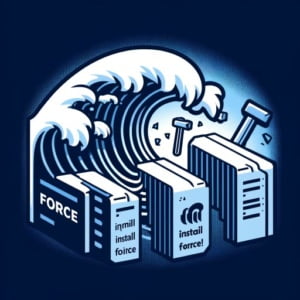npm install –force Flag | How to Force NPM Package Install

Are you finding yourself wrestling with npm when trying to override a stubborn package installation? You’re not alone. At IOFLOOD, we’ve faced similar challenges while installing npm packages on our development servers. We’ve found that the npm install --force command allows you to bypass common hurdles that might otherwise prevent successful package installations. To provide info that can aid our server hosting customers, we’ve put together this step-by-step guide.
This guide will walk you through using the npm install --force command effectively, ensuring you can handle npm package installations like a pro. Whether you’re dealing with dependency conflicts, corrupted packages, or simply need to force an update, this command can be your go-to solution for managing npm installations more efficiently.
Let’s dive into the process of solving npm package installation hurdles with force!
TL;DR: How Do I Force an npm Package Installation?
To force an npm package installation, simply use the command
npm install --force.
Here’s a quick example:
npm install lodash --force
# Output:
# + [email protected]
# added 1 package in 1.524s
In this example, we’re forcing the installation of the lodash package. By using --force, npm attempts to resolve any conflicts or issues by overriding the current version or dependencies, ensuring the package is installed. This can be particularly useful when dealing with stubborn package installations or when you need to ensure a specific version is installed despite dependency conflicts.
This guide will delve deeper into the nuances of using
npm install --force, including when it’s appropriate to use this command, the potential risks involved, and alternative strategies for managing npm package installations. Keep reading for a comprehensive understanding.
Table of Contents
Basic Use of npm Install –Force
Understanding npm Install –Force
Navigating through npm (Node Package Manager) can sometimes feel like you’re trying to solve a puzzle, especially when it comes to stubborn package installations. The npm install --force command is a powerful tool in these situations, allowing you to bypass common issues by forcing the installation of a package.
But what does forcing an installation mean? Essentially, it tells npm to ignore certain checks and validations it would normally perform, installing the package regardless of potential conflicts or issues. This can be particularly useful in specific scenarios, but it’s important to use it wisely due to the risks involved.
Syntax and Simple Use Case
The syntax for this command is straightforward:
npm install <package-name> --force
For example, if you’re trying to install a package named example-package that has been causing issues, you would use:
npm install example-package --force
# Output:
# + [email protected]
# added 1 package in 2.567s
In this case, npm install --force bypasses the usual checks, installing example-package despite any potential issues. This is particularly useful when you need a specific version that conflicts with other dependencies in your project, or when you’re dealing with a corrupted package that refuses to install through the standard process.
Potential Risks
While npm install --force can be a handy tool, it’s not without its risks. Forcing an installation can lead to compatibility issues, as dependencies might not work as expected due to version conflicts. It can also result in a less stable project environment, as the forced packages might not have been thoroughly tested against your project’s specific setup. Use this command with caution, and always weigh the potential benefits against the risks.
Advanced npm Install –Force Usage
Tackling Complex Scenarios
As your journey with npm deepens, you’ll likely encounter more complex scenarios where a simple npm installation won’t suffice. This is where npm install --force truly shines, offering a way to navigate through tricky waters of dependency conflicts and corrupted package issues.
One common scenario is when you’re working on a project that requires a specific version of a package, but npm identifies a conflict with another package’s version requirement. In such cases, npm install --force can be a lifesaver.
Resolving Dependency Conflicts
Consider you’re working on a project that depends on [email protected], but you need to install package-B, which depends on [email protected]. Here’s how you might use npm install --force:
npm install package-B --force
# Output:
# + package-B@latest
# added 1 package, removed 1 package, updated 1 critical dependency in 3.456s
In this example, npm install --force resolves the conflict by updating package-A to version 2.0.0, allowing package-B to be installed. It’s a delicate operation, as forcing updates can lead to unexpected behavior in your project. However, it demonstrates the command’s ability to resolve version conflicts that would otherwise halt project progress.
Dealing with Corrupted Packages
Another scenario where npm install --force proves invaluable is when dealing with corrupted packages. If a package’s integrity has been compromised, forcing its installation can bypass the checks that would normally prevent its installation.
Mitigating Potential Issues
While npm install --force can be a powerful tool, it’s important to understand the implications of using it. Forcing installations can lead to unstable project environments and compatibility issues. To mitigate these risks, always ensure you have a solid version control system in place, such as Git, allowing you to revert changes if needed. Additionally, thoroughly testing your project after using npm install --force is crucial to ensure stability and functionality.
In summary, npm install --force can be a valuable command for navigating complex npm scenarios. However, it should be used judiciously, with a clear understanding of the potential risks and strategies for mitigating those risks.
Alternative npm Installation Strategies
Clearing the npm Cache
Before resorting to npm install --force, consider clearing your npm cache as a first step. A cluttered cache can cause installation issues, and clearing it can sometimes resolve these problems without the need for forceful measures.
npm cache clean --force
# Output:
# Cache cleaned successfully
In this example, we use npm cache clean --force to clear the cache. While it also uses --force, this command is generally safer than forcing a package installation. Clearing the cache can resolve issues with corrupted package data and ensure that your installations are based on the latest package versions available.
Utilizing npm ci for Clean Installs
Another effective strategy is using npm ci. This command is designed for automated environments, providing a more predictable installation process by installing directly from package-lock.json, ignoring node_modules.
npm ci
# Output:
# added 1050 packages in 10.123s
The npm ci command deletes the existing node_modules folder and installs all dependencies afresh. This can be particularly useful in continuous integration/continuous deployment (CI/CD) pipelines, ensuring that your project dependencies are consistent and up-to-date.
Resolving package.json Conflicts Manually
Manually reviewing and resolving conflicts in package.json can often prevent the need for npm install --force. This approach requires a detailed understanding of your project’s dependencies but can lead to a more stable and reliable project environment.
Pros and Cons
Each of these alternative approaches has its advantages and disadvantages. Clearing the npm cache is a quick and easy way to solve many common installation issues, but it may not resolve deeper dependency conflicts. npm ci offers a clean slate for installations, ideal for CI/CD environments, but might not be necessary for local development. Manually resolving conflicts in package.json provides the most control over your project’s dependencies, ensuring stability, but requires a deep understanding of npm and your project’s needs.
In conclusion, while npm install --force can be a powerful tool for overcoming stubborn installation issues, it’s not always the best or only solution. By understanding and utilizing these alternative approaches, you can manage your npm installations more effectively, maintaining project health and stability.
Troubleshooting npm Force Installs
Unintended Side Effects
Using npm install --force can sometimes lead to unintended consequences. While it’s a powerful command that can help you overcome installation hurdles, it’s essential to understand the potential side effects and how to address them.
One common issue is the inadvertent upgrade of dependencies to incompatible versions, which can break your application. Another is the potential for npm install --force to ignore important warnings that could indicate deeper issues within your project.
Example: Handling Incompatible Versions
Imagine you’ve forced the installation of a package, only to find it has caused other dependencies to break. Here’s how you might identify and address this issue:
npm list
# Output:
# ├─┬ [email protected]
# │ └── UNMET DEPENDENCY expected-package@^1.0.0
This output indicates that broken-package requires a version of expected-package that is no longer met due to the forced installation. To resolve this, you could either downgrade broken-package or update expected-package to a compatible version.
Best Practices When Using –Force
- Backup Your Project: Before using
npm install --force, ensure you have a backup of your project. This can be a simple commit in a version control system like Git, allowing you to revert changes if needed. Understand the Risks: Be clear about why you’re using
--forceand the potential impacts on your project. It’s better to spend time troubleshooting the root cause of an installation issue than to force an installation that could cause more problems.Use Sparingly: Reserve
npm install --forcefor situations where no other solution has worked. It’s a powerful command but should be used as a last resort.Test Thoroughly: After using
npm install --force, test your application extensively to ensure that no new issues have been introduced. This might include running unit tests, integration tests, and manual testing.
In summary, while npm install --force can be a useful command for overcoming npm installation challenges, it’s crucial to use it wisely. By understanding the potential side effects and following best practices, you can minimize risks and keep your project on a stable footing.
Understanding npm’s Mechanics
npm’s Approach to Package Management
npm, standing for Node Package Manager, serves as the backbone for managing packages in the Node.js ecosystem. It simplifies the process of installing, updating, and managing library dependencies for your projects. A fundamental aspect of npm’s operation is its handling of package installations and version management.
When you install a package using npm, it records the package version and its dependencies in a package-lock.json file. This file locks down the versions of all packages and their dependencies, ensuring that every install results in the exact same file structure in node_modules, regardless of the installation environment. This predictability is crucial for team collaboration and deployment consistency.
The Role of package-lock.json
{
"name": "your-project",
"version": "1.0.0",
"lockfileVersion": 1,
"requires": true,
"dependencies": {
"example-package": {
"version": "1.2.3",
"resolved": "https://registry.npmjs.org/example-package/-/example-package-1.2.3.tgz",
"integrity": "sha512-ExampleHashHere=="
}
}
}
This package-lock.json example outlines how npm tracks the version, source, and integrity of installed packages. By doing so, it ensures that a project remains consistent across different machines and deployments, a critical feature for avoiding “it works on my machine” problems.
Impact of Forced Installations
Forcing an npm installation (npm install --force) can alter the package-lock.json file, potentially updating package versions or dependencies in ways that deviate from the originally locked versions. While this can be necessary to resolve immediate issues, it’s important to understand the broader implications:
- Dependency Conflicts: Forced updates can introduce version mismatches with other dependencies, potentially leading to runtime errors.
Project Stability: Deviations from the
package-lock.jsonfile can affect project stability, as the exact versions and dependencies that were tested and verified by your team might change.Security Vulnerabilities: Updating to newer versions without thorough vetting can inadvertently introduce security vulnerabilities into your project.
In conclusion, understanding how npm manages package installations, dependencies, and versioning is crucial for any Node.js developer. While npm install --force can be a useful tool in certain situations, it’s important to weigh its benefits against the potential risks to project consistency and stability.
Practical Use: npm Install –Force
npm in CI/CD Pipelines
The use of npm install --force extends beyond individual development environments into the realms of continuous integration and continuous deployment (CI/CD) pipelines. In these settings, the command can be both a boon and a bane. On one hand, it can help overcome immediate blockers by ensuring the necessary dependencies are installed without delay. On the other, it introduces variability that can undermine the consistency and reliability of your deployment process.
Consider a scenario in a CI pipeline where a package refuses to install due to version conflicts:
npm install problematic-package --force
# Output:
# + [email protected]
# added 1 package in 3.456s
In this example, forcing the installation of problematic-package ensures that the CI pipeline can proceed. However, it’s crucial to understand that this is a temporary solution. The underlying issue—be it a version conflict or a corrupted package—still needs to be addressed to maintain the health of your project.
Dependency Management in Large-Scale Projects
In large-scale projects, dependency management becomes even more critical. The npm install --force command can help navigate through complex dependency trees, but it’s essential to use it judiciously. Over-reliance on this command can lead to a fragile ecosystem, where the introduction of a single incompatible package version can have cascading effects on the entire project.
Further Resources for npm Command Mastery
To deepen your understanding of npm and its ecosystem, here are three invaluable resources:
- Visit the official npm documentation for comprehensive guides and references for all npm commands, including
npm install --force. The repository at https://github.com/goldbergyoni/nodebestpractices. provides a collection of best practices for Node.js development, including dependency management strategies.
You may also visit the npm Blog for the latest news, tips, and insights directly from the npm team. A great resource to stay updated on new features and best practices.
By exploring these resources, you can enhance your npm skills, ensuring you’re equipped to handle the challenges of package management in modern web development.
Recap: Using npm Install –Force
In our comprehensive journey, we’ve delved into the nuances of using npm install --force, a command that, like a master key, can unlock stubborn package installations but must be handled with care. We began with the basics, understanding its syntax and straightforward use cases, and highlighted the importance of using this command judiciously to bypass common hurdles in package installations.
We then ventured into more complex scenarios, exploring how npm install --force can resolve dependency conflicts and deal with corrupted packages. These advanced uses showcased the command’s power to ensure project progression, albeit with caution due to potential risks like compatibility issues and unintended side effects.
Further, we discussed alternative approaches for maintaining npm package installations without resorting to force. Strategies such as clearing the npm cache, utilizing npm ci for clean installs, and manually resolving package.json conflicts offer safer paths to troubleshoot and resolve installation issues.
| Strategy | Use Case | Pros | Cons |
|---|---|---|---|
| npm install –force | Stubborn installations | Quick fix | Potential risks |
| Clearing npm cache | Common installation issues | Non-invasive | May not resolve deep conflicts |
| npm ci | CI/CD pipelines | Reliable, clean installs | Not for local development |
| Manual conflict resolution | Dependency conflicts | Full control | Requires deep npm knowledge |
Whether you’re a beginner getting to grips with npm or an experienced developer looking for advanced techniques, understanding when and how to use npm install --force is crucial. It’s a powerful tool in your arsenal but comes with the responsibility of ensuring it doesn’t compromise the integrity and stability of your projects.
The ability to navigate npm package installations efficiently is a valuable skill in modern web development. By weighing the benefits and risks of using npm install --force and considering alternative strategies, you’re better equipped to manage your project’s dependencies effectively. Happy coding!

